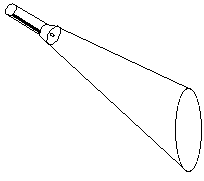
After Tycho's death, Kepler became the court astronomer, although the superstitious emperor was more interested in astrology than in the structure of the solar system. In 1619 Kepler published his third law: the square of the orbital period T is proportional to the cube of the mean distance a from the Sun (half the sum of greatest and smallest distances). In formula form
T2= k a3
with k some constant number, the same for all planets. Suppose we measure orbital periods in years and all distances in "astronomical units" or AUs, with 1 AU the mean distance between the Earth and the Sun. Then if a = 1 AU, T is one year, and k with these units just equals 1, i.e. T2= a3. Applying now the formula to any other planet, if T is known from the observations of many years, the planet's a, its mean distance from the Sun, is readily derived.
Finding the value of 1 AU in miles or kilometers, that is, finding the actual scale of the solar system, is not easy. This subject is discussed in the next section. Our best values nowadays are the ones provided by space-age tools, by radar-ranging of Venus and by planetary space probes; to a good approximation, 1 AU = 150 000 000 km.
|